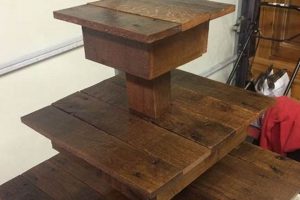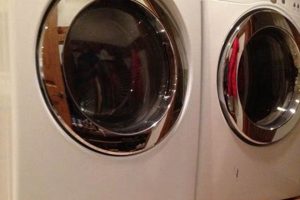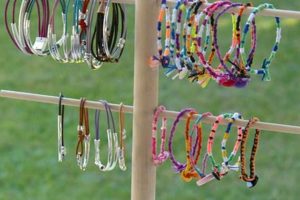A structure designed for supporting a kayak, often self-constructed, provides a stable platform for storage, maintenance, or display. These supports can be fashioned from various materials, including wood, metal, or repurposed items, tailored to specific kayak dimensions and user requirements. The creation of a custom kayak support offers a practical solution for managing kayak storage challenges.
The creation of personal kayak support structures presents a cost-effective alternative to commercially available options, allowing for customization to suit individual needs and spatial constraints. Such construction promotes resourcefulness and fosters a deeper understanding of structural design principles. Furthermore, these stands contribute to the longevity of the kayak by preventing direct ground contact, thus minimizing potential damage.
The following sections detail the process of constructing a kayak support, including material selection, design considerations, and step-by-step assembly instructions. The emphasis will be on providing clear and concise guidance for building a functional and durable support structure.
Construction Tips for Kayak Support Structures
The successful assembly of a durable and functional kayak support relies on careful planning and execution. Attention to detail throughout the construction process will ensure a safe and reliable storage solution.
Tip 1: Material Selection is Paramount: Choose materials appropriate for the intended environment. Pressure-treated lumber is recommended for outdoor applications to resist rot and insect damage. Metal supports should be treated with a rust-inhibiting coating.
Tip 2: Accurate Measurement and Marking: Prior to cutting any materials, meticulously measure and mark all components. Precise measurements ensure a structurally sound and aesthetically pleasing final product. Verify dimensions against the specific kayak model.
Tip 3: Prioritize Stability in Design: The base of the support should be wider than the kayak’s beam to prevent tipping. Incorporate cross-bracing to enhance lateral stability and distribute weight evenly.
Tip 4: Implement Secure Fastening Methods: Utilize high-quality screws, bolts, and adhesives designed for the selected materials. Pre-drilling pilot holes prevents splitting and ensures proper alignment.
Tip 5: Protect the Kayak’s Hull: Pad contact points with closed-cell foam or carpet to prevent scratches and abrasion. Regularly inspect padding for wear and replace as needed.
Tip 6: Consider Weight Distribution: Design the support to distribute the kayak’s weight evenly across all load-bearing members. Uneven weight distribution can lead to stress fractures and structural failure.
Tip 7: Ensure Adequate Height Clearance: Design the support with sufficient height to facilitate easy loading and unloading of the kayak. Account for potential obstructions in the storage area.
Adherence to these construction tips will result in a stable and reliable kayak support structure, safeguarding the kayak and providing a convenient storage solution.
The subsequent sections will explore alternative design approaches and advanced construction techniques for kayak support structures.
1. Stability
Stability represents a fundamental requirement for a self-constructed kayak support. A structure lacking inherent stability poses a significant risk of kayak damage, personal injury, and property damage. The absence of a stable base can lead to unintentional toppling, particularly when subjected to external forces such as wind or accidental contact. This element necessitates careful design and material selection to ensure a secure and reliable platform for the kayak.
Consider the implications of a narrow-based, top-heavy design. Such a support is inherently unstable and prone to tipping. A practical example is observed in supports constructed from lightweight, flexible materials like PVC without proper bracing. These supports are susceptible to deformation under the kayak’s weight, compromising their structural integrity and increasing the likelihood of failure. Conversely, a wider base constructed from robust materials such as treated lumber, coupled with diagonal bracing, enhances stability and load-bearing capacity.
Therefore, ensuring stability is paramount in any self-constructed kayak support. Proper planning, material selection, and construction techniques directly contribute to the overall safety and functionality of the support. The potential consequences of neglecting stability considerations underscore the importance of adhering to sound engineering principles and best practices throughout the construction process.
2. Material Durability
Material durability represents a critical consideration in the design and construction of kayak support structures. The longevity and structural integrity of the stand are directly dependent on the materials selected, particularly given the environmental conditions to which the stand will be exposed and the weight it must bear. Selection of inadequate materials can lead to premature failure, resulting in potential damage to the kayak and safety hazards.
- Resistance to Environmental Degradation
Materials used in outdoor kayak supports must withstand exposure to sunlight, moisture, and temperature fluctuations. Untreated wood, for instance, is susceptible to rot and insect infestation, significantly reducing its lifespan. Similarly, untreated steel will corrode, compromising its structural strength. Pressure-treated lumber, galvanized steel, or powder-coated metal offer enhanced resistance to these environmental factors, extending the service life of the stand. The choice of material directly impacts the long-term stability and safety of the support system.
- Load-Bearing Capacity and Structural Integrity
The selected materials must possess sufficient strength to support the weight of the kayak without deformation or failure. The species and grade of lumber, or the gauge and type of metal, will dictate the load-bearing capacity of the support structure. Overestimating the required strength can lead to unnecessary material costs, while underestimating it poses a risk of collapse. Proper engineering principles and material specifications are essential for ensuring the structure can safely bear the kayak’s weight under various conditions.
- Resistance to Wear and Abrasion
The surfaces that come into direct contact with the kayak hull should be constructed from or covered with materials that minimize abrasion and wear. Hard, abrasive surfaces can scratch or damage the kayak’s gel coat or hull material over time. Padding made from closed-cell foam, carpet remnants, or rubber provides a protective barrier, preventing direct contact between the kayak and the support structure. The selection of appropriate padding materials can significantly extend the life of the kayak’s hull.
- Joint Integrity and Fastener Selection
The durability of a kayak stand is influenced by the strength and longevity of the joints and fasteners used in its construction. Screws, bolts, and adhesives must be appropriate for the materials being joined and capable of withstanding the forces exerted on the structure. Improper fastener selection can lead to joint failure, compromising the overall stability and safety of the stand. Stainless steel fasteners are recommended for outdoor applications to resist corrosion and maintain joint integrity over time. Glue can also be used on conjuction to mechanically fasteners to make a stronger bond.
Considering these facets of material durability is essential for constructing a safe and reliable kayak support. The selection of appropriate materials, coupled with sound construction techniques, ensures that the stand can withstand environmental stresses, support the kayak’s weight, and protect its hull from damage over an extended period. Prioritizing material durability translates to a long-lasting and cost-effective storage solution.
3. Weight Capacity
Weight capacity is a critical engineering parameter in the construction of any kayak support. It dictates the maximum load the structure can bear without failure, directly influencing its safety and longevity. Insufficient weight capacity in a self-constructed kayak stand can lead to structural collapse, resulting in damage to the kayak and potential injury to individuals in the vicinity. The selection of materials and design configuration must, therefore, explicitly account for the kayak’s weight, with a safety margin incorporated to accommodate dynamic loads and material degradation over time. The relationship is causal: inadequate weight capacity directly causes structural instability and potential failure of the support.
Examples of inadequate weight capacity manifest in various ways. Using lightweight lumber designed for decorative purposes to support a heavy tandem kayak will invariably result in structural failure over time, if not immediately. Similarly, utilizing undersized metal tubing or insufficient welding in a metal stand will compromise its load-bearing capabilities. A real-world consequence of such miscalculations is a collapsed kayak stand, potentially damaging the kayak itself or nearby objects. Furthermore, the repeated stress on an under-engineered stand can lead to fatigue and eventual failure, even if the initial load appears to be supported. For instance, screws can shear, lumber can split, or welds can crack under sustained stress caused by inadequate weight capacity planning.
In conclusion, weight capacity is not merely a specification but a fundamental requirement for any kayak support. The calculated load-bearing capability of the design must exceed the kayak’s weight by a substantial margin, considering factors like dynamic loading, material degradation, and potential user error. Failure to prioritize weight capacity during design and construction jeopardizes the structural integrity of the support, potentially resulting in damage, injury, or loss. A proper understanding of structural mechanics and material properties is therefore essential for building a safe and reliable kayak stand.
4. Hull Protection
Hull protection is a paramount consideration in the construction of a self-assembled kayak support. The kayak’s hull, often constructed from fiberglass, polyethylene, or composite materials, is susceptible to damage from abrasion, impact, and prolonged pressure. A well-designed support integrates features that mitigate these risks, preserving the kayak’s structural integrity and aesthetic appeal. The absence of adequate hull protection can lead to costly repairs and reduced performance.
- Padding Material Selection
The choice of padding material is critical in preventing direct contact between the kayak hull and the support structure. Closed-cell foam, marine-grade carpet, or rubber are commonly employed due to their cushioning properties and resistance to water absorption. Open-cell foams are generally unsuitable as they retain moisture, promoting mold growth and accelerating material degradation. The thickness and density of the padding should be sufficient to distribute the kayak’s weight evenly and minimize pressure points. Specific application includes using pipe insulation to add extra cushion from edges of the support.
- Contact Point Design
The design of contact points on the support structure influences the distribution of pressure on the kayak hull. Broad, flat surfaces are preferable to sharp edges or narrow supports, which can concentrate stress and create indentations. Contoured supports that match the shape of the hull provide optimal weight distribution and prevent localized pressure. Consideration should be given to the placement of support arms to align with structural elements within the kayak hull, minimizing stress on unsupported areas. For example, the location should be near bulkheads.
- Abrasion Resistance
Materials used in the construction of the support structure, even when padded, should be selected for their abrasion resistance. Rough surfaces, such as unfinished wood or corroded metal, can scratch or gouge the kayak hull during loading and unloading. Smooth finishes, such as paint or powder coating, minimize friction and reduce the risk of abrasion. Regular inspection and maintenance of the support structure are necessary to identify and address any potential sources of abrasion. One common practice is using sanded edges to remove splinters.
- UV Protection Considerations
For kayak supports intended for outdoor use, protection from ultraviolet (UV) radiation is essential. Prolonged exposure to UV rays can degrade both the kayak hull and the padding materials, leading to discoloration, cracking, and reduced performance. UV-resistant coatings or covers can be applied to the support structure to mitigate these effects. Storing the kayak in a shaded area or using a kayak cover further protects the hull from UV damage. This becomes more important for plastic kayak to preserve its flexibility.
Integrating these hull protection measures into the self-assembly process ensures the longevity and performance of the kayak. Thoughtful design and material selection, coupled with regular maintenance, safeguard the kayak from damage, preserving its value and ensuring its continued usability. By paying due attention to these details, the do-it-yourself approach can yield a storage solution that is both functional and protective.
5. Adjustability
Adjustability, in the context of a self-constructed kayak support, refers to the capacity to modify the structure to accommodate kayaks of varying dimensions and hull configurations. This characteristic enhances the utility and longevity of the support by allowing it to adapt to changing needs and equipment. A fixed-dimension support, conversely, may become obsolete or inadequate if the user acquires a different kayak.
- Height Modification
Height adjustability facilitates easier loading and unloading of kayaks, particularly for individuals with limited strength or mobility. A higher support position reduces the need for bending and lifting, while a lower position may be preferable for storage in confined spaces. Examples include telescoping support arms or adjustable leg extensions that can be locked at various heights. The practical implication is a more ergonomic and accessible storage solution.
- Width Adjustment
Width adjustment allows the support to accommodate kayaks of different beam widths. This is particularly relevant for individuals owning multiple kayaks or anticipating future changes in their equipment inventory. Adjustable support arms, sliding crossbeams, or modular construction techniques enable modification of the support width. The benefit is the versatility to store a range of kayak sizes on a single stand.
- Angle Adjustment
Angle adjustment pertains to the inclination of the support arms, enabling the kayak to be stored at an optimal angle for drainage and stability. A slight tilt can prevent water from pooling inside the kayak hull, reducing the risk of mildew and corrosion. Adjustable hinges or pivoting support points allow for customization of the support angle. The outcome is improved kayak preservation and reduced maintenance.
- Customizable Support Padding
The ability to reposition or modify the padding on the support arms ensures optimal contact and weight distribution for different hull shapes. Kayaks with varying hull designs may require different padding configurations to prevent pressure points and distortion. Adjustable straps, hook-and-loop fasteners, or removable padding sections allow for customization. The result is enhanced hull protection and reduced risk of damage during storage.
These facets of adjustability collectively contribute to a more versatile and user-friendly self-constructed kayak support. By incorporating adjustable features, the support can adapt to changing needs, extend its lifespan, and provide a more secure and convenient storage solution for a range of kayak types.
6. Storage Efficiency
Storage efficiency, in the context of a do-it-yourself kayak support, denotes the optimization of space utilization for the storage of kayaks, accessories, and related equipment. This aspect is particularly salient in environments where space is limited, such as residential garages, apartments, or storage units. A well-designed stand maximizes storage density while maintaining accessibility and minimizing the footprint of the kayak storage solution.
- Vertical Storage Optimization
Employing vertical storage solutions is a key element of storage efficiency. Lifting the kayak off the ground and storing it vertically, either by suspending it from the ceiling or utilizing a vertical stand, frees up valuable floor space. This approach is particularly effective in garages or sheds where floor space is often congested with other items. Examples include pulley systems or wall-mounted racks that elevate the kayak, thereby minimizing its spatial intrusion. The consequence is increased usable floor area and improved organization within the storage environment.
- Collapsible and Modular Designs
Kayak support structures featuring collapsible or modular designs contribute to storage efficiency by allowing the stand itself to be compactly stored when not in use. A collapsible stand can be folded down for storage against a wall or in a closet, minimizing its footprint during periods when the kayak is in use. Modular designs allow components to be disassembled and reconfigured to accommodate different kayak sizes or storage layouts. This adaptability enhances the overall storage efficiency of the system, particularly in multi-purpose spaces.
- Integrated Storage Features
Incorporating integrated storage features into the kayak support further optimizes storage efficiency. Adding shelves, hooks, or compartments to the stand allows for the storage of paddles, life vests, and other kayaking accessories alongside the kayak itself. This consolidation of equipment reduces clutter and minimizes the need for separate storage locations. Examples include attaching a mesh bag or a series of hooks to the stand for storing paddles and life jackets, thereby centralizing kayaking equipment in a single location.
- Maximizing Wall Space
Utilizing wall space for kayak storage contributes significantly to storage efficiency. Wall-mounted racks or slings suspend the kayak horizontally against the wall, freeing up floor space and minimizing obstruction. This approach is particularly effective in narrow spaces or areas where floor access is limited. Properly installed wall mounts distribute the kayak’s weight evenly and prevent damage to the wall structure. The outcome is a streamlined storage solution that maximizes available space without compromising accessibility.
These considerations collectively illustrate the importance of storage efficiency in the design and construction of a do-it-yourself kayak support. By prioritizing vertical storage, collapsible designs, integrated storage features, and wall space maximization, individuals can create kayak storage solutions that are both functional and space-saving, optimizing the usability of their storage environments.
7. Construction Cost
Construction cost constitutes a primary determinant in the decision-making process for individuals contemplating a self-assembled kayak support. The expense associated with materials, tools, and labor directly influences the feasibility and attractiveness of this alternative compared to commercially available options. A critical assessment of construction cost necessitates a comprehensive accounting of all anticipated expenditures, including raw materials such as lumber, metal, or PVC; fasteners such as screws, bolts, and adhesives; protective padding materials; and any necessary finishing treatments or coatings. The overall cost should be evaluated in relation to the projected lifespan and utility of the finished kayak support. Overlooking even seemingly minor expenses can lead to budgetary overruns and diminish the economic advantages of pursuing a do-it-yourself approach. Materials prices can vary dramatically according to the region in which the project will be built.
The importance of construction cost extends beyond the mere financial outlay. It directly impacts the design choices made during the planning phase. For instance, individuals operating with a limited budget may opt for simpler designs employing readily available and inexpensive materials, such as repurposed lumber or basic PVC pipe. Conversely, those with a more substantial budget may choose to incorporate more sophisticated design elements, utilizing higher-quality materials such as pressure-treated lumber, galvanized steel, or custom-fabricated components. The trade-offs between cost and functionality must be carefully considered to ensure that the final kayak support meets the user’s needs without exceeding their financial constraints. A further practical consideration is the potential for cost savings through salvaging materials, such as scrap lumber from other projects, or utilizing tools already owned rather than purchasing new ones. Also it is important to shop for the best price and quantity. An example would be plywood, which can often be purchased as a “remnant” from home building box stores.
In summary, construction cost represents a pivotal factor in the development of a self-constructed kayak support. A thorough assessment of all associated expenses, coupled with a clear understanding of the trade-offs between cost and functionality, is essential for ensuring a successful and economically viable outcome. The challenges associated with managing construction costs underscore the importance of meticulous planning, resourceful material acquisition, and realistic budgetary projections. By carefully navigating these considerations, individuals can create custom kayak supports that are both cost-effective and tailored to their specific needs. A future trend to keep an eye on will be the dropping prices of 3D printed materials, and perhaps a 3D printer kayak stand.
Frequently Asked Questions
This section addresses common inquiries and misconceptions regarding the construction and utilization of self-assembled kayak support structures. The intent is to provide clarity and guidance based on established engineering principles and best practices.
Question 1: What is the primary benefit of constructing a personal kayak support versus purchasing a commercially available model?
Construction of a support structure often yields cost savings, and allows for customization tailored to specific kayak dimensions, storage space limitations, and user preferences. This approach enables optimization of design features and material selection to meet individual needs more precisely than standard commercially available models may allow.
Question 2: What material is most appropriate for building a kayak support intended for outdoor use?
Pressure-treated lumber is generally recommended for outdoor applications due to its resistance to rot, insect infestation, and degradation from exposure to moisture. Alternatively, galvanized steel or powder-coated metal offer superior durability and corrosion resistance in outdoor environments. The selection must account for the expected environmental conditions and the desired lifespan of the structure.
Question 3: How is adequate weight capacity determined for a DIY kayak support?
Weight capacity must exceed the kayak’s total weight, inclusive of any gear that may be stored on the support. The materials utilized and the structural design must be capable of withstanding this load with a safety factor applied to account for dynamic loads and material degradation over time. Consulting load-bearing charts for lumber and metal is crucial in determining appropriate material dimensions.
Question 4: What measures should be taken to protect the kayak hull from damage while stored on a support?
Padding all contact points with closed-cell foam, marine-grade carpet, or similar cushioning materials is essential. These materials minimize abrasion and distribute the kayak’s weight evenly, preventing localized pressure points. Regular inspection and replacement of worn or damaged padding are necessary to maintain hull protection. Also, inspect for protruding nails, screws and splinters.
Question 5: How can stability be enhanced in a self-constructed kayak support?
Stability is primarily achieved through a wide base, robust construction materials, and the incorporation of diagonal bracing. The base width should exceed the kayak’s beam to prevent tipping, and bracing should be strategically placed to resist lateral forces. Secure fastening of all components is critical to maintaining structural integrity.
Question 6: Is it necessary to apply a finish or coating to a DIY kayak support?
The necessity of a finish or coating depends on the materials used and the intended environment. Untreated wood benefits from a sealant or paint to prevent moisture absorption and decay. Metal surfaces should be coated with a rust-inhibiting primer and paint to prevent corrosion. Applying a finish enhances the durability and aesthetic appeal of the support.
The foregoing responses offer guidance on key aspects of kayak support construction. These considerations are critical for ensuring the safety, durability, and functionality of the finished structure.
The subsequent section will provide detailed instructions for building a basic wooden kayak support.
DIY Kayak Stand
This discourse has illuminated various facets of the “diy kayak stand” concept, emphasizing design considerations, material selection, construction techniques, and the importance of stability, durability, and hull protection. The economic advantages and customization options inherent in self-construction have been contrasted with the convenience of commercially available alternatives, thereby providing a comprehensive overview of the topic.
The information presented is intended to empower individuals to make informed decisions regarding kayak storage solutions. Responsible implementation of these principles will contribute to the preservation of watercraft and the efficient utilization of storage space. Readers are encouraged to apply this knowledge judiciously and to prioritize safety in all construction endeavors.







